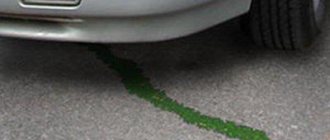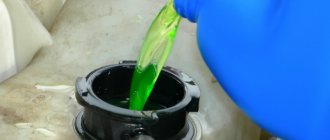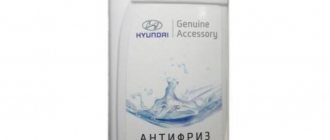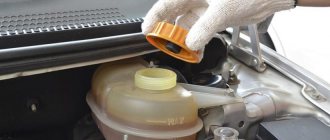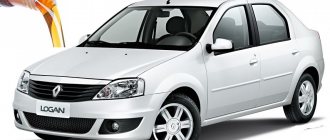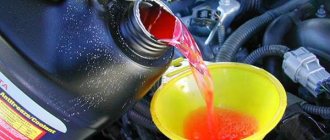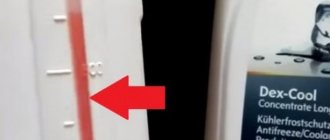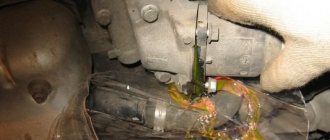When to change antifreeze?
The driver turns the car’s ignition key and the mechanisms “come to life.” Their friction is accompanied by the release of heat. A cooling system is initially provided to prevent overheating of the internal combustion engine.
The liquid circulates in a closed circuit and takes away heat from the working parts. Afterwards it passes by the radiator grilles, cools naturally and goes back to collecting heat.
The coolant was originally water. But it freezes at 0 °C with large expansion, and boils at 100 °C. We have developed a substance that does not freeze at sub-zero temperatures and does not boil at 105-120 °C - antifreeze - literally “anti-freeze”.
Cars leave the assembly lines of car factories with a full set of process fluids. Antifreeze is one of them.
The owner of a new car only needs to know when to change the antifreeze on the Kia Rio 3 so that the engine does not suffer prematurely.
Guided by two considerations:
- When the deadline specified by the manufacturer arrives. The manuals describe the frequency of the procedure - every 45 thousand km, or after three years, whichever comes first. According to the maintenance regulations, the deadline for the 4th generation Kia Rio 2021 is TO-3.
- There were clear signs that the cooling system was not coping with the task.
The official information is that the first replacement of antifreeze on the Kia Rio 3 should be carried out after 210,000 km or every 10 years. However, this is not true.
Replacement frequency, what antifreeze to fill
From the factory, Crown LLC A-110 antifreeze is poured into cars of the Korean manufacturer assembled in Russia. It is produced at the facilities of the TECHNOFORM enterprise. Retailed under the name Coolstream A-110.
Based on the data from the operating instructions, the first replacement should be carried out no later than 120 thousand mileage. All subsequent replacements are carried out depending on the fluid used. But in any case, the manufacturer recommends using the original.
For this car, the original fluid is Hyundai Long Life Coolant, which is produced by the Korean company Kukdong. There are several products in the product line, all of them have the same green color, but radically different composition. Therefore, the service life will be completely different.
For example, the one that is recommended to be used and written about on all forums, in the photo on the left, is considered outdated. It has not been supplied to conveyors for a long time; it has a service life of 2 years. Its codes for ordering: 07100-00200 (2 l.), 07100-00400 (4 l.).
In the photo on the right, created using the latest technology, it is considered the most modern (P-OAT) lobride antifreeze, with a service life of 10 years. It has all the approvals of the Hyundai/Kia concern and is supplied to assembly lines. Its article numbers for ordering: 07100-00220 (2 l.), 07100-00420 (4 l.).
How much antifreeze is in the cooling system, volume table
| Model | Engine capacity | How many liters of antifreeze are in the system | Original liquid / analogues |
| Kia Rio | gasoline 1.6 | 5.3 | Hyundai Long Life Coolant |
| gasoline 1.4 | Crown LLC A-110 | ||
| CoolStream A-110 | |||
| RAVENOL HJC Hybrid Japanese Coolant |
Signs of the need to replace the coolant
In a car's cooling system, antifreeze cools and lubricates engine parts, preventing metal corrosion. During operation, the coolant becomes contaminated with small chips, evaporates, and loses its properties. Additives in the mixture precipitate. Deposits cover the moving mechanisms of the power unit with a film: it begins to work worse.
Signs of aging that indicate that the antifreeze on the Kia Rio 3 needs to be replaced:
- foam appeared;
- the color has changed - the liquid has become cloudy;
- the mixture thickened and became jelly-like;
- sediment and flakes appeared;
- coolant level has dropped;
- the density of the composition has decreased (check with a hydrometer).
Each gives reason to change or add antifreeze to the Kia Rio 3.
When should you replace antifreeze in a car?
First, let's talk about the basics. It is recommended to replace it every 40-50 thousand kilometers if you live in an urban environment.
As for use, it is recommended to fill Rio 3 with new types of antifreeze of the G13 series, since they have excellent characteristics and have performed well in the cold. In addition, the G13 series antifreeze represents a generation of new antifreezes for foreign cars.
The main distinguishing feature of this mixture is (compared to G12 antifreeze) a more advanced ethylene glycol composition base - propylene glycol. In addition, in the new G13 series of antifreezes, you can notice a significant increase in anti-corrosion additives in the mixture.
The most important advantage of G13 antifreeze for Rio 3 is its almost endless service life. It would also be important to note the main difference between G13 and other cooling mixtures - it is maximum safety for the environment due to the destruction of propylene glycol at the outlet.
What is the composition of antifreeze for Rio 3
The variety of offers from manufacturers confuses car owners. To understand which mixture is suitable to replace Kia Rio 2013 antifreeze, we understand the components.
Coolant components:
- Ethylene glycol is a dihydric alcohol. Density at 20 °C is 1.1 g/cm3. The composition is slightly viscous, odorless. Boils at 196 °C, freezes at minus 12-13 °C.
- Water - add distilled water so that there is no deposit on the walls of the pipes. A 1:1 proportion increases the freezing point of the coolant to -40 °C and lowers the boiling point to 150 °C. A higher water content leads to the formation of foam - the system tubes become “aired” and the engine overheats.
- Additives - organic and inorganic substances - increase the lubricating and anti-corrosion properties of the material.
About additives and color:
- Inorganic ones - phosphates, burates, glycerin, silicates - are used in traditional antifreezes. Such liquids (blue color) last 2 years. These are antifreezes.
- Organic - carboxylic acids - form a thin (0.1 micron) layer on the tubes that does not interfere with the cooling of the unit and prevents the appearance of rust. Color - red, service life - 5 years. These are carbonoxysilicate additives.
- Hybrid - organic plus inorganic. The green composition lasts up to three years.
- Lobrid - minerals plus organic matter. A purple mixture that is recommended for replacing the coolant in Kia Rio 3. Manufacturers claim that such coolant is enough for the entire life of the vehicle. In Kia Rio 3 you will only need to add antifreeze.
To change antifreeze on a Kia Rio 3, choose a coolant taking into account the concept of “cavitation”. These are bubbles, they are formed from vibration of the cylinder head. They have a bad effect on the additive package of the cooling mixture. Carbon and lobride additives reduce cavitation. With such components they take the “cooler” for the Kia Rio 2012.
How to choose a good coolant?
When choosing antifreeze, first of all you should pay attention to the recommendations of the car manufacturer (indicated in the manual). At the time of buying:
At the time of buying:
- Estimate the cost of the selected product. Check prices at several retail outlets - if they differ significantly, it is better to refrain from buying; as a rule, counterfeit goods are sold much cheaper.
- Check the packaging for leaks.
- Check the properties of the additives used in the liquid - they should be gentle.
- Preference should be given to antifreeze in transparent containers. This will allow you to assess the presence or absence of sediment and the turbidity of the liquid.
- Foaming. The foam that appears during shaking should settle within 3-5 seconds.
- Check the quality of the label and packaging - carelessly glued parts may indicate that this is a fake. The bottle must contain a barcode, composition, classification and other mandatory information.
The highest quality coolants for Kia Rio
In car dealerships, Kia Rio 3 cars are sold with green G11 antifreeze. The main component is ethylene glycol.
Compositions that can replace antifreeze on Kia Rio 3:
- Shell Premium. The blue product of the Dutch-British company is sold as a concentrate, which is diluted 50/50 with water. The composition protects aluminum engines and is active in frosts down to -38 °C.
- Liqui Moly Langzeit Kuhlerfrostschutz. The German quality of ready-to-use blue coolant has gained popularity among Kiya owners. The composition lubricates and cleans the system of dirt and corrosion, and prevents overheating. Valid from -40 to +109 °C.
- Toyota Long Life Coolant Red Concentrate. Does not freeze at -37 °C. The red color comes from a package of additives that do not corrode the rubber and plastic parts of the system. Toyota products last a long time, but are more expensive than analogues on the auto chemical market.
- TCL Power Coolant Green. The coolant contains organic acids that do not precipitate. Russian frosts of 40° are not terrible with Japanese protection, although coolant fluidity deteriorates in such conditions. The composition boils at +110 °C. This carboxylate product is not mixed with any other.
- AGA Z. The coolant was developed in its own Russian laboratories. The basis of the composition is ethylene glycol, so it is not recommended to mix it with propylene glycol G13. The product is red in color, with an affordable price. Crystallizes in frost 40 °, the upper positive limit is 123 ° C.
- Sintec Unlimited. Branded goods from Obninskorgsintez are a new word in the car market. Hardens at -45 °C, good for 5 years.
- Felix Energy G12+. Innovative coolant line. The additive package gives the product anti-corrosion and anti-cavitation properties. The product is prepared using carboxylate technology.
The coolant is selected according to the manufacturer’s recommendations set out in the car’s service book.
Description of coolant for Kia Rio
The Kia Motors automaker uses its own substances for crossovers. These are products with product code MS 591-08 and JIS K 2234.
Similar versions are poured into specific Hyundai models, which are assembled on the same assembly line.
The composition contains the following elements:
- water purified from impurity ions;
- ethylene glycol (toxic dihydric alcohol);
- AC-110 concentrate.
The Russian market offers products that are ready for use. The car enthusiast does not have to dilute it with distilled water.
For baying, it is not necessary to buy an original product; analogues can be used. Such liquids are much easier to find and purchase, since they are cheaper than the original.
Replacing Kia Rio antifreeze with your own hands
The engine is cooled and the car is placed on the overpass. Prepare pliers, a funnel, and empty dishes for processing. You will need a syringe (a rubber bulb with a tube will do) and a rag.
Sequence of work:
- Turn the filler cap half a turn to relieve pressure in the system.
- They crawl under the car and remove the engine protection. The mudguard is located on the left side of the engine.
- Place an empty container under the drain plug.
- Unscrew the drain and filler plugs.
- Wait for the liquid to drain into the bucket.
- Afterwards the drain plug is put in place. First check the O-ring and change it if necessary.
- Use a syringe (bulb) to pump out the remaining liquid from the expansion tank.
- Fill with fresh coolant up to the “L” mark on the tank body. Close the filler neck.
- Start the engine. Warm up until the fan starts working.
- Add the mixture to level “F”.
This completes the work. When the engine has cooled down, check for leaks. Replacing antifreeze in a Kia Rio 3 with your own hands is demonstrated in the video.
Materials and tools for work
- Consider the size of the drain container - approximately 6 liters (in this case, an old canister is perfect for draining).
- Also bring a funnel with you (a funnel made from an old plastic bottle works great).
- A rubber bulb or a large probe or syringe for pumping out the mixture (required for pumping out antifreeze from the expansion tank).
- You will also need pliers to open the cooling system.
- Replacement should only be carried out with the engine turned off and already cooled down.
How much antifreeze is in the cooling system
In the manuals for the Kia Rio 3, it is noted that one refueling requires 5.3 liters of coolant. This volume is enough for both engine cooling and the interior heating radiator.
When the antifreeze level drops and the liquid appears clean, without flakes, you need to add antifreeze in the Kia Rio 3 to the maximum mark on the tank. If it is a concentrate, it is pre-mixed with distilled water.
It is better not to add fluid to a car purchased second-hand, but to change it completely. It is not known what was poured earlier - the compositions may curl or separate.
How to change antifreeze on a Kia Rio
On the Kia Rio, the drain plug is installed only on the radiator, so when replacing it you have to flush it. If this is not done, then the new coolant will mix with the old one.
Because of this, the first product will also lose its qualities, and its service life will become shorter.
Before replacing, you need to find out where the antifreeze is located on the Kia Rio. It is located in the engine cooling system, which consists of a radiator and a system of pipes running inside the engine.
Drain
How to drain antifreeze from a Kia Rio - step-by-step instructions:
- Place the machine on a flat surface and remove the protection.
- Unscrew the drain plug, which is located to the right of the radiator. Before doing this, place a container below where the waste product will be drained. For better access, remove the air intake.
- When the fluid flows out, remove the radiator cap.
- To ensure that the substance comes out completely, remove the lower pipe on the left side of the radiator.
- Also, remove the antifreeze from the reservoir on the Kia Rio. To do this, use a hose attached to the syringe or a rubber bulb.
Flush the system to remove residuals (approximately 1.5 L).
Flushing
First, close the drain valve, which is located under the radiator, after which they begin to fill it to the very top. Then fill the expansion tank and close the plugs. Warm up the engine to allow water to circulate throughout the cooling system. To reduce time and mix the liquid, it is recommended to gas.
If the fan started working and the pipes warmed up, then the water passed a large circle. After turning off the ignition, wait until the engine cools down, then drain the water. The procedure is carried out several times until the liquid becomes clear.
Fill
After flushing, the cooling system is ready for the next step.
How to add antifreeze to a Kia Rio:
- It is better to use a concentrate, which you need to dilute yourself.
- The water does not drain completely, and 1-1.5 liters remain. Therefore, take this point into account when mixing.
- Slowly pour diluted antifreeze into the radiator. In order for it to be better distributed and the air to escape, remember the pipes.
- When the container is filled to the top, move to the expander. When the FULL mark is reached, stop filling.
- Warm up in the same way as when washing, with gas changes.
- After turning off the engine, leave the car to cool and check the antifreeze level in the Kia Rio. If it is not enough, then add more.
How to add antifreeze to a Kia Rio - Car repair and maintenance
2008 Corolla manual transmission
When servicing all brands of cars, the list of essential work includes changing or adding oil to the vehicle engine. But remember that the box also contains oil for lubrication.
In this regard, we will consider in more detail the issues related to its replacement in the 2008 Toyota Corolla manual transmission: what functions does it perform in the gearbox; does the transmission oil burn out and should it be added, as in an engine; recommendations according to which manual transmission maintenance of this car model is carried out.
THIS IS INTERESTING: How to bypass activation lock on Apple watch?
What is the function of transmission oil?
What remains for our client to do? Modern auto oils, all that are used in the engine and transmission, consist of a base and a set of additional compounds - additives. Basically, the quality of the lubricating function is determined by the base, and the additional package of additives only corrects and improves its performance properties.
Transmission systems, in addition to lubrication, have one more important task. When the manual transmission gears in mesh rotate, a lot of heat is generated. In the gearbox of a moving car, the temperature fluctuates around 150 degrees Celsius; here, at the very point of contact of the gears, it can rise to 300 degrees. The oil poured into the manual transmission also performs a heat-removing function, cooling the parts here and even preventing critical overheating of the box.
How often do you change transmission oil?
Under enormous temperature loads, the oil begins to foam, and at the same time its lubricating properties are significantly reduced. Also, during use, additives burn out, which again aggravates the performance of the protective function.
The result of an untimely change of lubricant is the formation of scuffing on the main gear - during operation, its gears begin to emit a typical hum; after 500-1000 km, the teeth of the gearbox parts cannot withstand the increased load and begin to collapse.
https://www.youtube.com/watch?v=tjDcTxIADM4
If proper measures are not taken, the Corolla's manual transmission may jam or completely fail.
2008 Toyota Corolla
- These are front-wheel drive cars, the manual transmission of which experiences the greatest load, as opposed to rear-wheel drive cars. To be able to maintain the functionality of the box for a long period, a scheduled oil change should be carried out every 50-60 thousand kilometers, and with a brutal driving style or for cars participating in racing, the period should be reduced to 30-40 thousand.
Checking the gearbox oil level
During vehicle operation, the level of transmission oils in the manual transmission decreases, therefore, in addition to changing them, they should also be topped up regularly. The reasons for checking the level are any signs of configuration during the operation of the box. Checking the level and then adding oil are easy operations that can be done at home.
Work order:
- The car must be placed on a flat horizontal surface above the inspection hole or raised using a lift. The level check should be done no earlier than 10 minutes after the vehicle is stopped in a working manner, with the engine turned off.
- The surface of the box should be cleaned around the level plugs and breather to prevent dirt from getting inside.
- Unscrew the cap and be sure to wipe it clean.
- Check the oil level - it should reach the bottom edge of the level plug hole.
- If the level is insufficient, unscrew the breathing valve (breather) located in the upper part of the manual transmission.
- Topping up should be done through the hole in the breathing valve in small portions until oil flows out of the hole for the level plug. For topping up, use a funnel and a suitable sized hose.
- Screw the plug into the area and tighten it with the required force.
- Install the breather to the area.
Changing the oil in a Toyota Corolla manual transmission #GarageLife
Subscribe to channel 2.
Changing the oil in a manual transmission on a TOYOTA Corolla e11
TOYOTA Corolla
e11.
changing the oil
in the manual transmission.
I poured in oil
for automatic transmissions of cars.
Changing the gearbox oil
Changing the oil in the manual transmission of a Toyota Corolla is also a fairly common job. To complete this task you need:
- Drive the car a little so that the box
warms up. - Go to the inspection hole in another way and remove the left wheel by placing the car on a jack.
Attention! Some of the work is performed under the machine, so for your own safety, install hemp under the machine.
- Unscrew the drain plug (bolt) and drain the used oil into any suitable container. If the car has been used, the oil will be slightly warm.
- You need to wait until it completely drains. Of course, additionally suck out the remaining sediments with a syringe with a curved tip.
- Next we need to unscrew the 2nd bolt, which we first have to reach not from below, but from above.
THIS IS INTERESTING: Renault Sandero oil change It can be found under the air duct that goes from the air filter to the engine. - We unscrew this bolt, through this hole we can introduce new oil.
- Install the 1st bolt (drain plug) to its destination and tighten it securely.
- To add oil, a long funnel is useful. We insert it into the hole where the 2nd bolt was located.
- We fill in new transmission oil.
- We tighten the 2nd bolt back.
What gear oil is recommended for Corolla?
Auto Toyota
2008 Corollas are equipped with 5- and 6-speed manual transmissions. For the working version of the shift, the 5th mortar will need approximately 1.9 liters of oil, the 6th mortar - 2.4.3.
When choosing brands, you should not give preference to cheap and bad products; it is better to purchase more expensive, unfortunately high-quality products from recognizable brands, or otherwise branded products produced by Toyota.
Source: https://avtomotiv-tomix.ru/obsluzhivanie/kak-dolit-antifriz-v-kia-rio.html
What components does the system consist of?
Among the primary elements of the Kia Rio 3 circuit cooling engine are the following:
- radiator;
- a pump that circulates antifreeze throughout the system;
- expansion tank;
- a set of pipes and lines;
- an electric fan located in front of the radiator (it provides additional heat extraction from the radiator honeycombs);
- the liquid itself, the volume of which is 5.3 liters.
How to properly add antifreeze to a car: instructions
Many drivers carry out the procedure for replacing and adding coolant themselves. Sometimes a lot of questions arise: adding cold or hot, choosing antifreeze, ways to avoid airing the system. Parts are often made of non-identical materials, and changing antifreeze will negatively affect the functions and integrity of the cooling system.
Manufacturers have come up with different refilling methods. Fluids are poured into the radiator for Hyundai Solaris and Ford Focus. The second method is through the expansion tank (Kia Rio, Renault Logan). From the general point: the mixture is poured into the car when it is cold. Ways to add liquid while preserving the car are described below.
THIS IS INTERESTING: What should be the weight of the ball for throwing?
Antifreeze: can I add it?
For effective operation, there must be a heat-removing liquid inside the system circuit. The cooling mixture contains a certain percentage of water. During operation, it comes into contact with high temperatures and evaporates. There are criteria when you need to top up or completely change antifreeze.
If there is not enough antifreeze, it must be added, otherwise there is a threat to normal cooling, and air locks may form. The working fluid gradually begins to change properties, losing active substances. Control the amount of antifreeze and top up on time. Make sure that the liquid you add matches the standards already added to the tank.
How often should antifreeze be added?
Car manufacturers give different service life of the coolant mixture. Topping up is carried out as the product is used, since the boiling point evaporates the water component. Maintain the level of antifreeze; there is no clear time frame for filling.
Unforeseen circumstances may occur that determine how often the procedure must be performed. Unnoticeable hose leaks, cracks in metal components of the car, radiator corrosion. If you frequently add antifreeze, inspect (the bright color of the mixture helps) the tightness of the system when the engine is hot, where pressure is created.
Is it possible to add antifreeze of different colors?
Adding liquids of different colors is not advisable, but acceptable. The color scale is not a strictly regulated norm. Each manufacturer awards its product with a color. To refill correctly, use the same antifreeze or carefully select a different one based on class and composition.
To rely on color differences, you need to consider the scale introduced by Volkswagen. In this list, each class gets its own color scheme. G11 – traditional or silicate coolants. Color - blue or green.
G12, G12+, G12++ are made from organic acids. Such mixtures are colored red, orange or lilac. G13 is a safe propylene glycol liquid. They are colored purple or yellow.
Conclusion: do not rush to add red liquid - with green composition.
Is it possible to fill in antifreeze of a different brand, but of the same color?
There are no strict standards. There is no guarantee that a liquid of the same color as yours, but of a different brand, will be identical. Antifreeze from another manufacturer may be made on an incompatible base and contain incompatible additives, which will damage the cooling system. After making sure that the solution poured into the car and the solution you are purchasing are compatible, use a liquid of a different brand without being tied to the color.
Is it possible to add distilled water to antifreeze?
The substances are sold concentrated along with ready-made mixtures. You need to add distilled water to the concentrate, since it does not contain undesirable components (chlorine, fluorine and others). Regular tap water forms scale on the walls of the system, which will worsen the heat transfer properties. The separated parts can clog the parts responsible for the movement of liquid along the circuits, and the machine will begin to boil.
Distillation removes harmful substances. Provided that the liquid level has dropped slightly, only water can be used. Remember that this affects the properties of the antifreeze that was previously filled.
Is it possible to add antifreeze to antifreeze?
The aggressive properties of antifreeze are very sensitive to other components, and what will happen after topping up is unpredictable. Possible crystal formation, corrosion of aluminum components, and corrosion of hoses. There is a release of sediment flakes that are dangerous for moving parts and filters, and the additives of the infused antifreeze are neutralized.
Conclusion - nothing can be added to antifreeze, with the exception of distilled water, but it lowers the freezing point. If you dilute antifreeze with water in a ratio of about 50/50, the engine will work, but mentally say goodbye to the car’s pump and thermostat.
What kind of antifreeze can I add if I forgot the brand of the old one?
When you need to add coolant, but the data on the previous one is lost, it is best not to take risks. If you just don’t know the brand of the old one, it’s not so bad. It is permissible to add another identical class to the existing one. The first owner of a car from the showroom needs to find information from the manufacturer. It’s worse when the type of antifreeze is unknown. It is better to flush and completely replace the coolant.
What antifreeze to fill in Hyundai Solaris
Car enthusiasts are interested in the question of how to replace the factory coolant on a Japanese car. Hyundai Solaris should be filled with green liquid CoolStream A-110 or Crown LLC A-110 from the factory.
If the color of the old fluid or antifreeze corresponds to class G11, then the same must be poured into the car. Every car produced in 2012, 2013 and 2015 uses the G12+ class. With G12++ antifreeze (like Opel Astra J), it can only be mixed with G13.
What is the best antifreeze to fill in Renault Logan
The French cool their engines with their own yellow Renault Type D fluids. This antifreeze is suitable for 1.4/1.6/2 liter engines. The basis of the mixture is ethylene glycol, they belong to class G12. Mix the concentrate with distilled water, proportion 1: 0.8. There is no need to use G12+. You need to add fluid into the expansion tank between the minimum and maximum marks.
What antifreeze to fill in Kia Rio
Starting from the second generation, the car is filled with G12+ class coolants at the factory. Older foreign cars were filled with traditional green G11 coolant. For Kia 2013 - 2014, you can pour red mixtures with distilled water into the tank.
Topping up antifreeze in Kia Rio
A car of a Korean concern receives adding coolant to the expansion tank. Add antifreeze when the engine is cold; the fluid level should reach the Full mark.
- First, prepare the liquid in a clean container. Take one part of the distillate and the mixture (proportions recommended in the instructions for the Kia Rio). Select the proportions correctly for correct operation and protection of the cooling system.
- Remove the expansion tank cap without touching the hose going to the radiator. There is a tube in the tank, by pulling it out you can get the filler neck.
- We top up and return the hose to its place, close the plug on the neck, and turn on the engine. Detailed description in the photo.
THIS IS INTERESTING: How to connect AirPods to iPhone 5s?
Topping up antifreeze when cold or hot?
The fluid level should be refilled when it is cold. When the engine is cold, the coolant does not lose capacity; if it is hot, the volume changes under pressure. Vapors from uncooled antifreeze can cause burns when opening the tank lid (thermal and chemical). If the mixture is cold: no pressure is created in the system, and you can see how much mixture needs to be added.
Source: https://DaciaClubmd.ru/repair/kak-dolivat-antifriz
The order of steps for changing the coolant. mixtures
- To begin with, you should turn the throat cap half a turn, which will make it possible to reduce the pressure in the car system itself and carry out the subsequent steps with greater safety.
- Crawl under your Kio Rio, then unscrew the engine protection and remove the internal shield, which protects the left side of the engine from soot and dirt getting into it.
- Next, simply unscrew the mudguard on the right side of the engine.
- After this, place a canister under the radiator drain to collect the mixture.
- Completely unscrew the drain plug of the engine cooling mechanism.
- Unscrew the top of the filler container.
- Next, you can partially unscrew the plug (if the pressure level drops, then unscrew it entirely).
- After draining the mixture from the radiator, screw everything back in as before.
- Loosen the compression force of the valve on the internal radiator pipe, then unscrew it and drain the remaining mixture from the engine.
- Using a large syringe, you should pump out the old antifreeze from the expansion tank and pour in fresh antifreeze.
- Fill in fresh mixture to cool the engine until the mixture begins to flow into the expansion tank. Next, simply close the lid.
Towards the end of the replacement, it is worth turning on the car’s engine and letting it warm up before the fan starts working (which will make it possible to ensure that all parts in the engine, including its cooling system, are working correctly).

